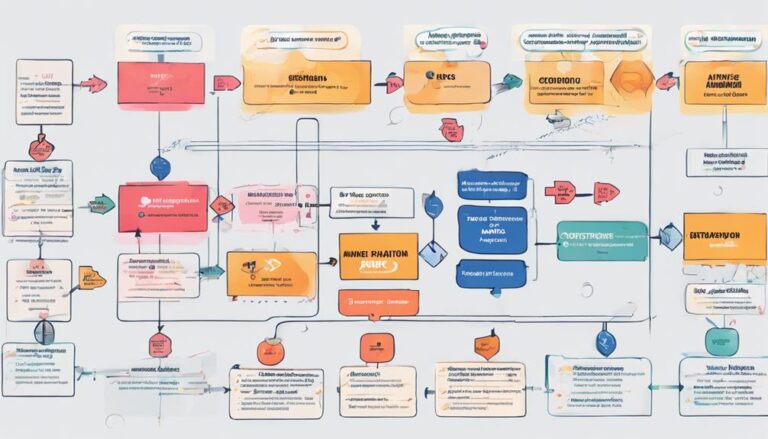Optimizing Your Healthcare Website for Lead Generation
To optimize your healthcare website for lead generation, focus on user-friendly design, clear call-to-action buttons, and mobile responsiveness. Enhance credibility through social proof and engage with high-quality, informative content. Implement local SEO strategies for attracting potential patients. Set up analytics to track user behavior and continuously test and optimize for improvements. Remember, strategic design and compelling content are key to attracting and converting patients.
Key Takeaways
- Enhance user experience with user-friendly design and clear visual hierarchy.
- Drive conversions by optimizing call-to-action buttons with vibrant colors and strategic placement.
- Ensure mobile responsiveness through responsive design elements and simplified navigation.
- Improve SEO performance with keyword research, on-page optimization, and backlink building strategies.
- Optimize lead generation with effective form placement, compelling call-to-action buttons, and social proof integration.
User-Friendly Website Design
To enhance lead generation on your healthcare website, prioritize creating a user-friendly design that optimizes user experience and encourages interaction. Usability testing is an important step in ensuring that your website is intuitive and easy to navigate for visitors. By conducting usability tests, you can identify any pain points or areas of improvement in the user journey, allowing you to make informed design decisions that enhance the overall user experience.
Implementing a clear visual hierarchy is essential in guiding visitors to the most important elements on your website, such as contact forms or service offerings. By strategically organizing content and visual elements based on their importance, you can direct users' attention effectively and improve engagement. A well-defined visual hierarchy also contributes to a more professional and polished look for your healthcare website, instilling trust and credibility in your brand.
Compelling Call-to-Action Buttons
Enhance user engagement and drive conversions by strategically crafting compelling call-to-action buttons on your healthcare website. When designing your call-to-action buttons, consider color psychology to evoke specific emotions and actions from your visitors. For example, using vibrant colors like red or orange can create a sense of urgency, prompting users to act quickly. In contrast, soothing colors like blue or green may convey trust and calmness, ideal for healthcare settings.
Another vital factor to optimize is button placement. Make sure your call-to-action buttons are strategically located where they are easily visible and accessible. Typically, placing buttons above the fold or at the end of valuable content increases the chances of user interaction.
Consider the following table for a quick reference on color psychology and button placement:
| Color | Psychology |
|---|---|
| Red | Urgency, action |
| Blue | Trust, calmness |
| Green | Growth, health |
| Orange | Creativity, enthusiasm |
Mobile Responsiveness Optimization
Craft responsive design elements that adapt seamlessly to various mobile devices, guaranteeing peak user experience and engagement on your healthcare website. When optimizing your healthcare website for mobile responsiveness, consider the following key strategies:
- Performance Testing: Conduct thorough performance testing to guarantee fast loading times and smooth functionality across different mobile devices. Use tools like Google's PageSpeed Insights to identify and address any performance bottlenecks.
- Image Optimization: Optimize images for mobile devices by compressing file sizes without compromising quality. This can help improve loading speeds and overall user experience on mobile devices.
- Responsive Layouts: Implement responsive layouts that adjust seamlessly to different screen sizes, ensuring that your healthcare website looks and functions well on smartphones, tablets, and other mobile devices.
- Mobile-Friendly Navigation: Simplify navigation menus and buttons for mobile users, making it easy for them to find information and take desired actions on your healthcare website.
SEO Strategy Implementation
When it comes to optimizing your healthcare website for lead generation, understanding the basics of keyword research, implementing on-page optimization techniques, and strategizing backlink building are key factors in improving your SEO performance.
By conducting thorough keyword research, you can target the right audience and increase your website's visibility in search engine results.
Utilizing effective on-page optimization and building quality backlinks will further enhance your website's authority and drive more organic traffic to your healthcare platform.
Keyword Research Basics
Conducting thorough keyword research is crucial for effective SEO strategy implementation in healthcare website optimization for lead generation. To guarantee your website ranks well and attracts relevant traffic, follow these key steps:
- Understand Your Audience: Analyze your target market to identify their search habits and preferences.
- Competitor Analysis: Evaluate competitor keywords to uncover opportunities and refine your own keyword strategy.
- Search Volume Trends: Monitor search volume trends regularly to capitalize on popular keywords.
- Long-Tail Keywords: Incorporate specific long-tail keywords related to healthcare services offered to attract more qualified leads.
On-Page Optimization Tips
Analyzing and optimizing on-page elements is vital for enhancing the SEO performance of your healthcare website and boosting lead generation efforts. Content relevance plays a key role in attracting and engaging visitors. Make sure that your content is informative, engaging, and tailored to address the needs and queries of your target audience.
Additionally, optimizing page load speed is essential for providing a seamless user experience. Fast-loading pages not only improve user satisfaction but also positively impact your search engine rankings. Prioritize optimizing images, reducing unnecessary scripts, and leveraging browser caching to enhance your website's speed.
Backlink Building Strategies
Implementing effective backlink building strategies is essential for optimizing the SEO performance of your healthcare website and increasing its online visibility. To enhance your link building efforts, consider the following strategies:
- Engage in Outreach Campaigns: Reach out to relevant healthcare websites or blogs to establish partnerships and acquire backlinks.
- Create High-Quality Content: Develop informative and engaging content that other sites would want to link back to.
- Utilize Social Media Platforms: Share your content on social media to attract more visitors and potential backlinks.
- Monitor and Analyze Backlink Performance: Regularly track the effectiveness of your link building initiatives and adjust your strategies accordingly.
High-Quality Content Creation
To enhance lead generation on your healthcare website, focus on crafting engaging and informative content that resonates with your target audience. A well-thought-out content strategy is essential for attracting visitors and turning them into leads. When creating content, consider your audience's needs, preferences, and pain points. Conduct research to understand what topics are relevant to them and how they consume information online. By aligning your content with the interests of your target audience, you can increase engagement and build credibility.
Incorporating audience engagement tactics such as interactive elements, videos, and infographics can make your content more appealing and shareable. Encourage feedback and discussions to foster a sense of community around your healthcare website. Consistently providing valuable and high-quality content establishes your website as a trusted resource in the healthcare industry. Remember to optimize your content for search engines by using relevant keywords and meta tags to improve visibility and attract organic traffic. By focusing on high-quality content creation, you can effectively drive lead generation on your healthcare website.
Lead Capture Form Optimization
When optimizing lead capture forms on your healthcare website, consider strategic form field placement, compelling call-to-action button design, and seamless auto-fill feature integration. These elements play an important role in enhancing user experience, increasing form completions, and ultimately driving lead generation on your site.
Form Field Placement
Positioning your lead capture form fields strategically on your healthcare website can greatly impact the number of leads generated. When considering form field placement, you must focus on optimizing the user experience to encourage conversions effectively.
Here are four key considerations for enhancing your lead capture form placement:
- Form Field Alignment: Align form fields in a single column to guide users easily through the completion process and improve conversion rates.
- Visibility: Place the form above the fold on your webpage to make sure it's immediately visible without the need for scrolling, increasing lead generation.
- Whitespace: Utilize ample whitespace around the form fields to enhance readability and draw attention to the essential information.
- Mobile Optimization: Make certain your form is responsive and optimized for mobile devices to capture leads across all platforms efficiently.
Call-to-Action Button Design
For ideal lead generation on your healthcare website, make sure that the design of your call-to-action button is strategically crafted to maximize conversions. When it comes to button color psychology, consider using contrasting colors that stand out on the page. Red and green are often associated with urgency and success, respectively. Additionally, pay attention to call-to-action placement strategies. Position the button where it's easily visible, usually above the fold and after providing sufficient information. A well-designed call-to-action button can have a substantial impact on your lead generation efforts.
| Button Color Psychology | Call to Action Placement Strategies |
|---|---|
| Red for urgency | Above the fold |
| Green for success | After providing information |
Auto-Fill Feature Integration
Craft a seamless user experience by seamlessly integrating an auto-fill feature into your lead capture forms to optimize data collection and streamline the conversion process on your healthcare website. When implementing this feature, make sure you prioritize data security and user privacy to build trust with your audience.
Here are four key considerations for auto-fill feature integration:
- Efficiency: Speed up form completion for users by automatically populating common fields.
- Accuracy: Reduce errors in data entry by pre-filling information based on known user details.
- Customization: Tailor the auto-fill feature to gather relevant data specific to your healthcare services.
- Transparency: Clearly communicate how user data is stored and used to maintain trust and compliance with privacy regulations.
Social Proof Integration
To enhance the credibility of your healthcare website and increase lead generation, integrating social proof is an essential strategy that leverages real-life testimonials and endorsements from satisfied customers. Testimonials showcase the positive experiences of previous patients, instilling trust and confidence in potential leads. By prominently featuring testimonials on your website, visitors are more likely to perceive your services as reliable and effective.
Additionally, collaborating with social media influencers within the healthcare industry can further enhance your website's reputation. Social media influencers have a loyal following and can greatly impact the decision-making process of their audience. When influencers endorse your healthcare services, their followers are more inclined to trust and engage with your brand.
Integrating social proof not only validates the quality of your services but also creates a sense of community and reliability. By strategically showcasing testimonials and leveraging social media influencers, you can effectively boost lead generation and establish a strong online presence in the competitive healthcare industry.
Local SEO Enhancement
Enhance the visibility of your healthcare practice by implementing targeted local SEO strategies that optimize your website for higher search engine rankings in your specific geographic area. To improve your local SEO and attract more potential patients, focus on the following key strategies:
- Optimize Local Directory Listings: Guarantee your practice is listed accurately on popular local directories like Yelp, Healthgrades, and Yellow Pages. Consistent information across these platforms boosts your online credibility and helps search engines understand your location relevance.
- Google My Business Optimization: Claim and optimize your Google My Business listing with updated information, including your address, phone number, and business hours. Encourage satisfied patients to leave positive reviews to improve your local search ranking.
- Local Keyword Targeting: Incorporate location-specific keywords throughout your website content to signal to search engines that your services are relevant to users in your area.
- Mobile-Friendly Website Design: Optimize your website for mobile devices as a large percentage of local searches are conducted on smartphones. A responsive design enhances user experience and can positively impact your local SEO efforts.
Analytics Tracking Setup
To optimize your healthcare website for lead generation, tracking user behavior and implementing conversion rate optimization strategies are essential.
By setting up analytics tracking, you can gain valuable insights into how users interact with your site, allowing you to make data-driven decisions to improve user experience and ultimately drive more conversions.
Understanding these key metrics will help you tailor your website to better meet the needs of your target audience and increase your lead generation effectiveness.
Tracking User Behavior
Implement robust analytics tracking to gain in-depth insights into user behavior on your healthcare website. By analyzing data such as heatmaps and click-through rates, you can make informed decisions to enhance user experience and drive lead generation.
Here are four key aspects to focus on:
- Page Interaction: Track how users engage with different elements on your pages.
- Bounce Rates: Monitor the percentage of visitors who leave your site without taking any action.
- Navigation Paths: Understand the routes users take through your website to identify popular pathways.
- Conversion Funnels: Analyze the steps users take before completing a desired action, such as signing up for a newsletter or requesting a consultation.
Conversion Rate Optimization
Establish comprehensive analytics tracking to enhance the conversion rate of your healthcare website effectively. By focusing on landing page optimization and lead nurturing strategies, you can drive more conversions. A key aspect of increasing conversions is through A/B testing to identify the most efficient elements and content on your website. Guarantee proper conversion tracking is in place to measure the success of your optimization efforts accurately. Monitor user behavior closely to understand where improvements can be made and where potential leads are dropping off. By investing time in analyzing data and testing different approaches, you can refine your website to better engage visitors and convert them into valuable leads.
| Landing Page Enhancement | Lead Cultivation | A/B Experimentation |
|---|---|---|
| Enhance page relevance and clarity | Cultivate leads with personalized content | Test various elements for superior performance |
| Focus on compelling CTAs | Engage leads through email campaigns | Compare variations to determine the most effective approach |
| Optimize for mobile compatibility | Provide valuable resources to steer leads | Measure conversion rates accurately |
Continuous Testing and Optimization
Enhance your healthcare website's lead generation potential through a systematic approach of continuously testing and optimizing its performance. By implementing continuous testing and optimization strategies, you can guarantee that your website is consistently improving to attract and convert leads effectively.
Here are four key steps to help you in this process:
- Utilize A/B Testing: Implement A/B testing strategies to compare different versions of your website and determine which one generates more leads. This data-driven approach allows you to make informed decisions on optimizing your site for better conversion rates.
- Monitor User Behavior: Analyze user behavior on your website to identify areas that may need improvement. By understanding how users interact with your site, you can make targeted optimizations to enhance the user experience and increase lead generation.
- Optimize Conversion Funnels: Continuously optimize your website's conversion funnels to streamline the user journey towards becoming a lead. Identify any bottlenecks in the conversion process and make necessary adjustments to improve lead capture rates.
- Iterate Based on Data: Use data-driven insights from continuous testing to make iterative improvements to your website. By consistently analyzing performance metrics, you can refine your lead generation strategies for best results.
Conclusion
By optimizing your healthcare website for lead generation, you can greatly increase your chances of converting visitors into valuable leads.
Did you know that websites with a compelling call-to-action can boost lead generation by up to 200%?
Implementing user-friendly design, mobile responsiveness, SEO strategies, high-quality content, social proof, local SEO, and analytics tracking are all key components to maximizing lead generation on your healthcare website.
Keep testing and optimizing to guarantee continued success.







